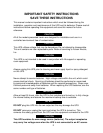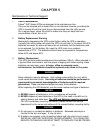
Communications Interface
The UPS provides both a contact closure and a true RS-232 computer
interface.
The definition and setup for RS-232 is as follows:
Baud Rate : 2400 bps
Data Length : 8 bits
Stop Bit : 1 bit
Parity : None
Pin #6: RS-232 data Tx out
Pin #7: Common for Pin #6 and Pin #9
Pin #9: RS-232 data Rx In
The definition and setup for DB9 (optional) is as follows:
Pin #2: AC Power Failure
Pin #4: Common GND of Pin #2 & Pin #5
Pin #5: UPS Battery Low
Pin #6: Turn off UPS
Pin #7: GND for Pin 6
The computer interface pin-out is stated above for reference only. Use
Pin #4 as the common for Pins #2 and #5. Pins #2 and #4 are
normally closed and will open when the utility fails. Pins #5 and #4 are
normally open and will close at the low battery indication.
The UPS will shut down when a 5-12 Vdc voltage is applied across
Pins #6 and #7 for three seconds, while the UPS is on battery mode.
6. DO NOT BLOCK UPS AIR VENTS. THE UPS MUST NOT BE
INSTALLED IN AN ENCLOSED AREA.
7. If you have not already done so, connect the equipment to be
protected to the UPS output receptacles located on the rear panel.
Verify that the connected equipment does not exceed the rated output
(in watts) of the UPS.
8. Select the proper line cord and connect it to the UPS power inlet.
Plug the UPS power cord into the nearest grounded wall outlet. If the
UPS does not power up automatically, depress and hold the control
button located on the UPS front panel until the UPS turns on.
IMPORTANT
5


















